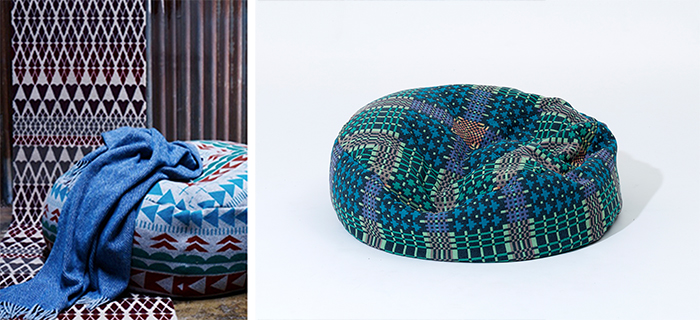This month our guest blogger is Arabella McNie, the curator of the Campaign for Wool Interiors Collection, which is part of the fifth anniversary celebrations of HRH The Prince of Wales’ Campaign for Wool. Her edit of fifty wool designs are be exhibited at London’s Southwark Cathedral from the 5th – 12th October during Wool Week (6th– 12th October).
The Wonder of Wool
‘Over the last few decades, wool has been overlooked as we’ve embraced modern man made fabrics and the hype that surrounds technology, or coveted the luxury of cashmere and silk. The humble sheep and its coat of clever wool became the poor relation as we shuddered at the thought of scratchy school jumpers and ugly carpet. But it’s now time to give it a second look.
The Campaign for Wool works hard to redress the balance, offering support and encouragement along the chain of production from wool producer to end product, while working to promote the uptake of the traditional skills needed to keep the wool industry relevant in this century and beyond.
Last year I made it my goal at Wool House, the exhibition hosted by Campaign for Wool at Somerset House in London, to show how versatile wool can be – that it’s not just tartan or beige carpet, and I was delighted when asked to work with the Campaign again, this time curating a collection of products across the interiors and lifestyle sectors. I knew I’d find some really amazing things and my only real worry was how to keep the selection to about 50 pieces.
As I started to research the collection, and discuss ideas, two main trends became clear. The first was that colour and pattern were back in a big way. After years of taupe and neutrals, this is to my mind a wonderful thing. Designers are looking back to traditional weaves and patterns, and reworking them to make them fresh and exciting.
Take carpet for instance. We are learning to appreciate the feeling of a soft floor underfoot, the benefits for sound absorption and how it helps to keep a space warmer for longer, but who wants an unstylish floor? Margo Selby’s Fair Isle carpet design for Alternative Flooring inspired by her own craft of weaving, feels familiar and comforting like a much loved sweater, but her distinctive use of colour brings a new dimension. It’s a design that can cross the divide between urban and country interiors, whether it’s used as an accent piece in a hallway, or as wall-to-wall over a larger area.
Fair Isle wool carpet and runner, Margo Selby for Alternative Flooring
Similarly, for her Field Day floor cushion for SCP, Donna Wilson has taken inspiration from welsh double cloth blankets to create her design. The fabric is woven in Wales, using traditional techniques, but by applying her very modern colour sense to the cloth, has elevated this most prosaic form of seating into a statement piece.
Field Day floor cushion for SCP by Donna Wilson – Traditional Welsh Blanket, Collinge Antiques
The soft shape of the floor cushion is reminiscent of the folds of a blanket. Osborne and Little’s Fitzgerald fabric is a wonderful reinterpretation of plaid, upscaled and recoloured, it has tradition at its root, but it feels very now.
At the other end of the spectrum, the second main trend was the use of undyed wools. This also seems to tap into the desire for traceability and provenance, with designers seeking out yarn from heritage breeds. The range of colour available across the grey, cream and brown palette is quite astonishing and anything but dull. The natural variations in shades are instantly appealing and add depth to the yarn without the need for dye. When she agreed to create a wool version of her iconic and sculptural pendant lights, Naomi Paul’s instinctive decision was to use undyed British yarn. I can’t wait to see the result.
Sculptural wool pendant light by Naomi Paul
Naturally pearl grey Shetland wool was used to create the waffle cushions by Solva Woollen Mill. They wanted to use local slate for the buttons, and the colour and texture of the wool has created a perfect partnership. Pure Lana use undyed Merino and Corriedale wools in their entire collection. The throws have a beautiful tactile quality with a chunky weave structure created on antique Argentinian looms, and are finished with extravagant fringes. They are simply irresistible and make me impatient for winter.
Craftsmanship and wool go hand in hand, whether you are a home crafter, or working on a larger scale. It’s humbling to see the skills learned and employed to create beautiful things. Tapestry is an art form more commonly seen in museums these days, but again with a renewed fashion- led interest sparked by artists such as Tracey Emin and Greyson Perry, it’s starting to make a comeback. Caron Penney is a talented weaver who is recreating Gillian Ayres abstract work Tirra Lirra. It’s an arresting piece and one that will translate brilliantly from canvas to wool.
Wool Tapestry by Caron Penney
Similarly, Fine Cell Work have collaborated with Pentreath & Hall to produce two of their designs inspired by 18th century marble and stone floor patterns. The wool needlepoint really brings the three-dimensional quality of the patterns alive.
Pentreath & Hall for Fine Cell Work
It has been a privilege to delve again into the world of wool, meeting old friends, finding new talents and being amazed at the skills and ingenuity of designers and crafters.’








